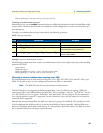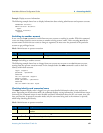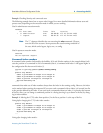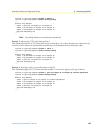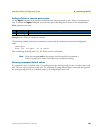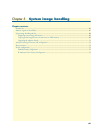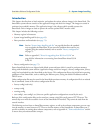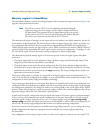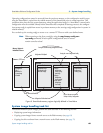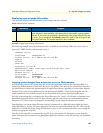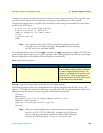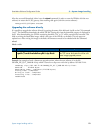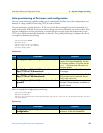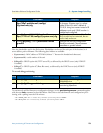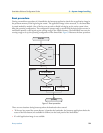
Memory regions in SmartWare 67
SmartWare Software Configuration Guide 5 • System image handling
Memory regions in SmartWare
The SmartNode’s memory contains several logical regions and several physical regions as shown in figure 8 on
page 68, each separate from the other.
Note You will use a remote TFTP server for uploading and downloading the
application image, the driver images, and the various configuration files to
the SmartNode. The command syntax in SmartWare requires you to prefix
the file path on the TFTP server with tftp: followed by the absolute file path.
You need to start from the root directory of the TFTP server.
The three physical regions of memory are the remote tftp server’s memory, the Volatile memories, and the Per-
sistent memory in the SmartNode. The remote tftp server has one logical region, tftp:, which can contain vari-
ous configuration files and batch files for system software upgrade/download. Within the SmartNode the
Volatile physical region contains one logical region, system:, which is random access memory (RAM). When no
power is applied to the SmartNode, the system: region contains no data, no configuration—nothing; it is vola-
tile. The system: region contains the current running configuration, called running-config.
The third and last physical memory region is the Persistent portion. It has two logical regions called flash:
and nvram:.
• The logical region flash: stores the application image, the driver images and the bootloader image. These
images are not lost when the SmartNode is powered off.
• The logical region nvram: stores the various configuration files. The factory default configuration file is
always present in nvram:, and can be restored as the running-config by pressing the reset button. For those
models that do not have a reset button, use the
copy command. The startup-config and user-specific con-
figurations are also stored in nvram:.
The factory configuration is read-only. It is contained in the logical region nvram: of the SmartNode. It is
used—if no user-specific configuration is available—to start-up SmartWare with a minimal functionality. This
configuration is named factory-config in SmartWare terminology.
On powering up a SmartNode (or pressing the Reset button on applicable units) with no pre-configured user
configuration files, the default factory-config file is also the startup-config and the running-config. Upon changing
any configuration parameters, the changes are made to the running-config in the system: region of the Volatile
memory. Unless these changes are copied into startup-config or another user-named configuration file, all con-
figuration changes will be lost if the SmartNode is powered down.
A dedicated user-specific configuration must be created and stored in the nvram: region of persistent memory.
In fact, you may create numerous user-specific configurations in the same SmartNode, but if only one dedi-
cated user-specific config is required, you may save it in startup-config by using the
copy running-config
startup-config
command. Any future time you restart the SmartNode, it will use this saved configuration. In
other words, the startup-config configuration file becomes your default operating configuration.
If you have created and saved numerous user-defined operating configuration files, you can change the startup
default configuration file simply by copying the selected config file into startup-config and rebooting
the SmartNode.
Any configuration stored in logical region nvram: or system: can be copied to a remote server by using TFTP.



